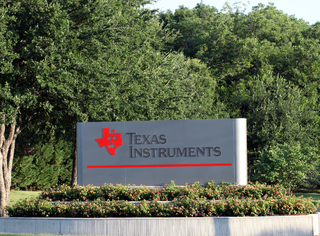
Texas Instruments Incorporated (TI) is an American semiconductor company headquartered in Dallas, Texas that designs and manufactures semiconductors and various integrated circuits. It is one of the top 10 semiconductor companies worldwide based on sales volume. The company's focus is on developing analog chips and embedded processors, which account for more than 80% of its revenue. TI also produces TI digital light processing technology and education technology products including calculators, microcontrollers, and multi-core processors. The company holds 45,000 patents worldwide as of 2016.

The TI-89 and the TI-89 Titanium are graphing calculators developed by Texas Instruments (TI). They are differentiated from most other TI graphing calculators by their computer algebra system, which allows symbolic manipulation of algebraic expressions—equations can be solved in terms of variables, whereas the TI-83/84 series can only give a numeric result.

The TI-99/4 and TI-99/4A are home computers released by Texas Instruments in 1979 and 1981, respectively. The TI-99 series competed against home computers such as the Apple II, TRS-80, Atari 400/800, and VIC-20.
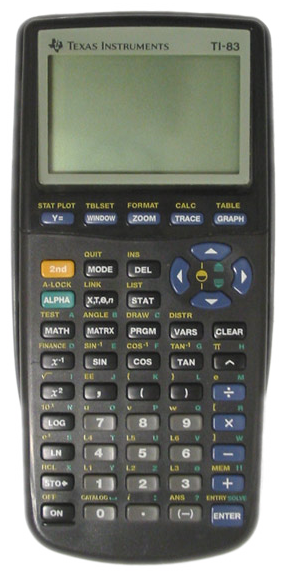
The TI-83 series is a series of graphing calculators manufactured by Texas Instruments.

The TI-81 was the first graphing calculator made by Texas Instruments. It was designed in 1990 for use in algebra and precalculus courses. Since its release, it has been superseded by a series of newer calculators: the TI-85, TI-82, TI-83, TI-86, TI-83 Plus, TI-83 Plus Silver Edition, TI-84 Plus, TI-84 Plus Silver Edition, TI-84 Plus C Silver Edition, TI-Nspire, TI-Nspire CAS, TI-84 Plus CE, and most recently, the TI-84 Plus CE Python. Most of them share the original feature set and 96×64-pixel display that began with this calculator, with the exceptions of the TI-84 Plus C Silver Edition and the TI-84 Plus CE family.

The TI-68 was a scientific pocket/desktop calculator produced by Texas Instruments. It was introduced in 1989 and was modified in 1991 to produce a less expensive and possibly more durable version. The adjacent picture is the later version. It was discontinued in 1997.

The TI-30 is a scientific calculator manufactured by Texas Instruments, the first model of which was introduced in 1976. While the original TI-30 was discontinued in 1983 after several design revisions, TI maintains the TI-30 designation as a branding for its low and mid-range scientific calculators.

The Texas Instruments LPC Speech Chips are a series of speech synthesizer digital signal processor integrated circuits created by Texas Instruments beginning in 1978. They continued to be developed and marketed for many years, though the speech department moved around several times within TI until finally dissolving in late 2001. The rights to the speech-specific subset of the MSP line, the last remaining line of TI speech products as of 2001, were sold to Sensory, Inc. in October 2001.

Speak & Read is an electronic learning aid made in 1980, by Texas Instruments. Speak and Read was part of a family of learning toys i.e. "Speak & Math" and "Speak & Spell".
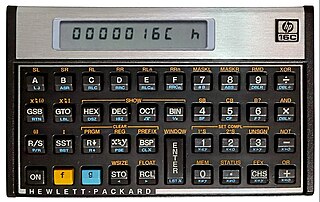
The HP-16C Computer Scientist is a programmable pocket calculator that was produced by Hewlett-Packard between 1982 and 1989. It was specifically designed for use by computer programmers, to assist in debugging. It is a member of the HP Voyager series of programmable calculators. It was the only programmer's calculator ever produced by HP, though many later HP calculators have incorporated most of the 16C's functions.
Texas Instruments TI-36 is a series of scientific calculators distributed by Texas Instruments. It currently represents the high-end model for the TI-30 product lines.

The TI-Nspire is a graphing calculator line made by Texas Instruments, with the first version released on 25 September 2007. The calculators feature a non-QWERTY keyboard and a different key-by-key layout than Texas Instruments's previous flagship calculators such as the TI-89 series.
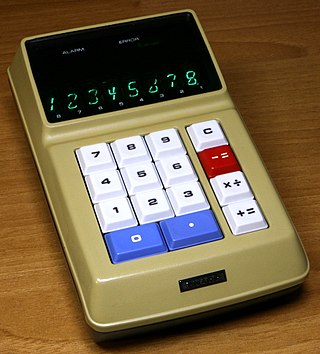
The Sharp EL-8, also known as the ELSI-8, was one of the earliest mass-produced hand-held electronic calculators and the first hand-held calculator to be made by Sharp. Introduced around the start of 1971, it was based on Sharp's preceding QT-8D and QT-8B compact desktop calculators and used the same logic circuits, but it was redesigned to fit in a much smaller case.
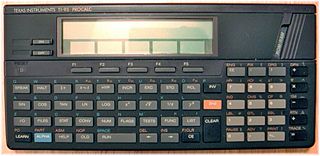
The TI-95, also called the TI-95 PROCALC, is a keystroke programmable calculator and was introduced in 1987 by Texas Instruments. It was rather large, measuring 3.7" by 8" by 1" and had a 16-character alphanumeric display for the main display, and a set of 5 3-character displays for use as menu items. It had 8kB of onboard RAM, capable of being partitioned by the user between program steps for the built-in program editor, numerically-labelled registers, and file memory. It could also be connected to PC-324 compatible printers. The calculator came with a hard carrying case which closes around it. Compatible ROM and extra RAM could be placed in the expansion slot in the upper right corner of the device, which came from the factory with a dummy protector cartridge labelled "ROM/RAM". Texas Instruments would release three compatible ROM cartridges, one containing advanced mathematics functions such as the Gamma function and Newton's method labeled Mathematics, a second containing statistics features such as the Normal and Student's t distributions and various statistical tests labeled Statistics, and a third containing functions and data on common industrial chemicals labelled as Chemical Engineering. An 8kb RAM expansion cartridge could also be placed into the cartridge slot, and RAM cartridges could be given names to allow a user to have multiple cartridges, each with its own library of custom-made functions. The calculator also supported the use of a cassette tape drive to store programs. Programs are entered into the calculator's memory as a keystroke program, in which the user effectively records a macro which is played back when the program is run.

A ROM cartridge, usually referred to in context simply as a cartridge, cart, or card, is a replaceable part designed to be connected to a consumer electronics device such as a home computer, video game console or, to a lesser extent, electronic musical instruments.

Texas Instruments TI-35 was a series of scientific calculators by Texas Instruments. The original TI-35 was notable for being one of Texas Instruments' first use of CMOS controller chips in their designs, and was at the time distinguished from the lower-end TI-30 line by the addition of some statistics functions.

The Little Professor is a backwards-functioning calculator designed for children ages 5 to 9. Instead of providing the answer to a mathematical expression entered by the user, it generates unsolved expressions and prompts the user for the answer.

The TMS1000 is a family of microcontrollers introduced by Texas Instruments in 1974.

The TI-54 was a scientific calculator produced by Texas Instruments, primarily marketed towards engineers and science professionals. It was introduced in 1981, and at the time was the only calculator that could deal with complex numbers. It was discontinued in 1983.

Dataman was an educational toy calculator with mathematical games to aid in learning arithmetic. It had an 8-digit vacuum fluorescent display (VFD), and a keypad. Dataman was manufactured by Texas Instruments and was launched on 5 June 1977.
























